The last edition of Broken Memories touched on the diphtheria epidemic of 1880 in the Hamilton district which claimed the life of Archdeacon Gustaves Innes on 9 April that year. This edition goes back to those times and looks further at the epidemic and those touched by it. The next headstone is located in the Church of England section of the cemetery, only a short distance from the grave of Gustaves Innes
GORMAN
While organising photos after a visit to the Hamilton cemetery, I came to the headstone above and found I could only make out the name Gorman and the year 1880. However, a search of the Hamilton Spectator quickly revealed the sad story of stationmaster Thomas Gorman and his three children, Ethel, Jane, and Thomas Jr. As recorded on the Gorman headstone “erected by the kindness of his Hamilton friends”, the family was victims of the “same dreadful disease” Diphtheria.
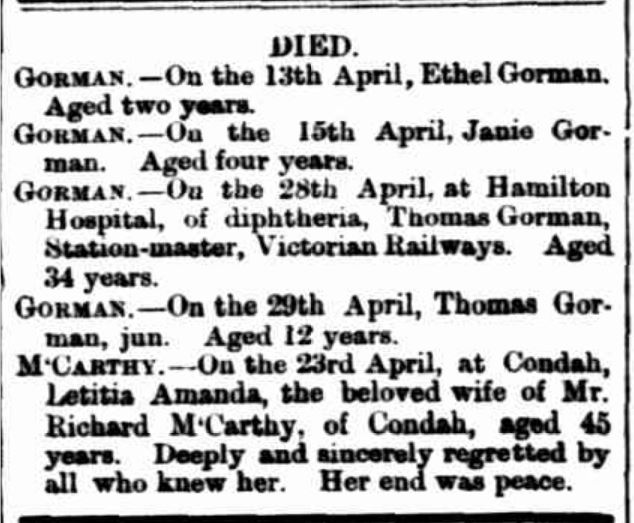
Family Notices (1880, May 1). Hamilton Spectator p. 2. http://nla.gov.au/nla.news-article225489876
Reading more about Thomas, I discovered something to pique the curiosity of this Carlton Football Club supporter of four decades. Thomas, or Tom as he was known, was a pioneer of the club.
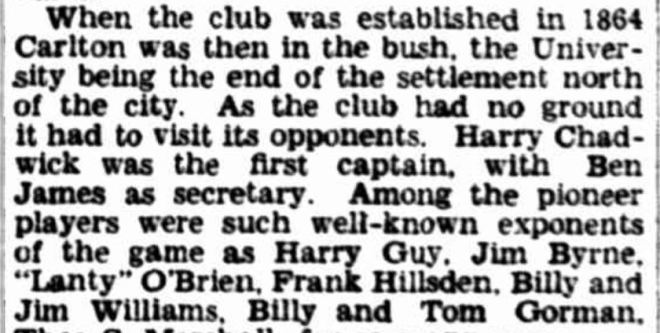
“COME ON THE BLUES!” (1938, June 11). The Australasian p. 21. http://nla.gov.au/nla.news-article144371844
I also found he was involved in events in the late 1870s, now part of Australian folklore. I needed to take a closer look at the life of Thomas Gorman, so I went back to the beginning.
Thomas was born in 1845 at Paramatta, New South Wales, a son of British Army soldier Patrick Gorman and Margaret Ryan (1). A brother William was born in 1848 (2). By the early 1860s, the Gormans were in Melbourne without their father Patrick, and living in Hotham (North Melbourne). Thomas began work with Victorian Railways around 1862 to support his family.
The Gorman boys were athletic and played cricket. One of the earliest references to the brothers playing together was from March 1864 in a match between their team Alma Cricket Club (later West Melbourne Cricket Club) against a Young Victorians’ side. Thomas was nineteen and William was sixteen.

Richmond (second Eleven) v. Lonsdale. (1864, March 12). Bell’s Life in Victoria and Sporting Chronicle p. 4. http://nla.gov.au/nla.news-article199055492
It was also in 1864, that father Patrick Gorman was back in his family’s life and causing trouble for them, enough to force Thomas to have his father charged, stating his job was at risk. Patrick would be no stranger to the City Police Court over the following years.
The boys continued with their cricket and soon they were also playing the emerging game of Australian Rules Football. On 28 May 1864, a match was played between Royal Park and Eastern Hill Football Clubs, and a Gorman was named for Royal Park. Since neither team kicked any goals during the match, they resumed it on 11 June 1864. There were three further matches in which a Gorman played for Royal Park, on 16 July 1864 against Eastern Hill, on 6 August 1864 against Scotch College, and 13 August 1864 against Fitzroy.
On 17 May 1865, a meeting was held at the University Hotel to elect office bearers for the Carlton Football Club. Ben James was elected secretary and his first duty was to write to James Linacre requesting he take on the role of President. It was decided to adopt the rules of the Melbourne Football Club. An intraclub scratch match was played a week later and on 27 May 1865, the Carlton Football Club wearing a uniform of orange, including an orange cap with a blue stripe took on Melbourne Grammar. One of the Gorman brothers was on the team.
It was the first year of the Athletics Sports Committee Challenge Cup. There was no draw, rather, teams simply challenged the holder of the cup to a match. The winner would then hold the cup. The team to win three consecutive cups was the permanent holder. Throughout the season, Thomas was strong for Carlton in the ruck and was often named among Carlton’s best, as was William.
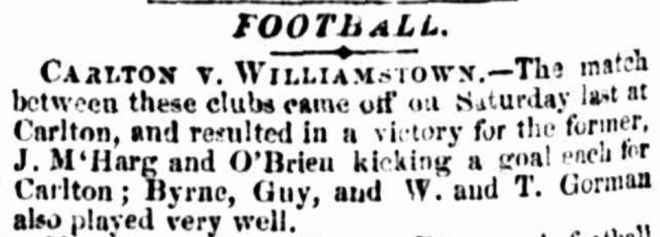
FOOTBALL. (1865, July 18). The Herald p. 2. http://nla.gov.au/nla.news-article244470269
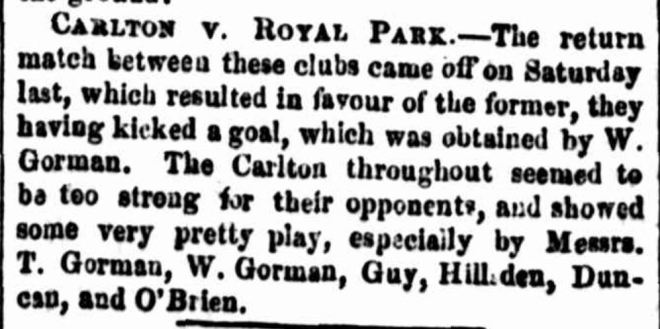
FOOTBALL. (1865, August 7). The Herald p. 2. http://nla.gov.au/nla.news-article244468789
I was able to find six games played by the Gorman brothers in 1865 for Carlton. In four, T.Gorman and W.Gorman were both named, while in the other two games, only “Gorman” was given in the team list. Three of the matches were against the Warehouseman’s Club and the remainder were Melbourne Grammar, Royal Park, and Williamstown.
The Gormans didn’t just play for the Carlton Football Club. Under the rules of the Challenge Cup, players could play for two clubs. On 16 September 1865, Melbourne Football Club was set to play South Yarra for the Challenge Cup in the last game of the season. Bell’s Life in Victoria and Sporting Chronicle described them as the “two crack teams of the colony” However, Melbourne was without some of its gun players. Instead, “two good players, Gorman and Toohey, of the Carlton Club, had been impressed for the occasion”. Melbourne won the game and the 1865 Challenge Cup and it would not be the last time a Gorman played for Melbourne.
The 1866 season saw a lot of football played by the Gorman brothers both for Carlton and Melbourne, although I have found if Carlton played Melbourne, the brothers played for Carlton. But no matter who they played for, they always gave their best. In a match on 14 July, for Melbourne against South Yarra, William was described as “little Gorman the cricketer”, giving a standout performance while Thomas was described as a “heavyweight” in the centre.
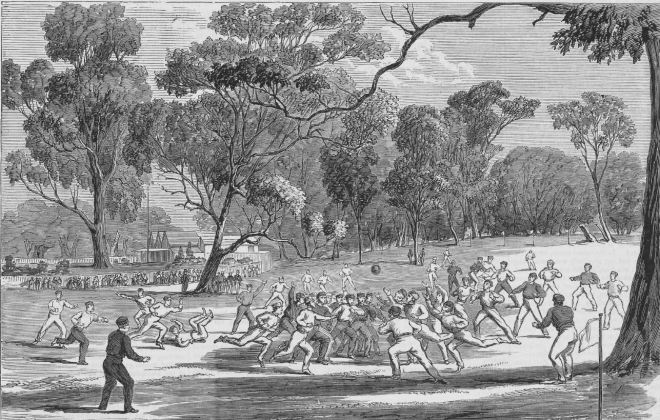
THE EARLY DAYS OF AUSTRALIAN RULES FOOTBALL A FOOTBALL – A MATCH AT RICHMOND PADDOCK IN 1866. Image courtesy of the State Library of Victoria http://handle.slv.vic.gov.au/10381/111640
When there wasn’t a Challenge Cup match going with Carlton or Melbourne, the Gormans played in matches such as the Australians vs The World on 7 July 1866. The intraclub match was open only to bona fide members of the Melbourne Football Club. There was a return match on 4 August, but the Gorman brothers played for Carlton that day against South Yarra. On 16 June 1866, William played for Melbourne FC while Thomas played in the opposing team made up of Civil Servants. It was also in 1866 when one of the Gormans was elected to the Carlton FC committee.
The brothers played again in 1867, but not with the same frequency as ’66. Besides, Tom had other things going on in his life. On 10 August 1867, Thomas, then twenty-two, married Alice Ann Travis in West Melbourne (3) and their first child, Thomas was born in 1868 (4). Soon after the family moved to Riddells Creek where Thomas was a porter at the railway station. A daughter, Margaret was born there in 1870 (5). Meanwhile, a Gorman was consistently named for Carlton and sometimes Melbourne for the football seasons of 1868, ’69, and ’70. If an initial was given in the team lists or results, it was “W.Gorman”. Given that, it’s possible William is in the team photo below from 1870.
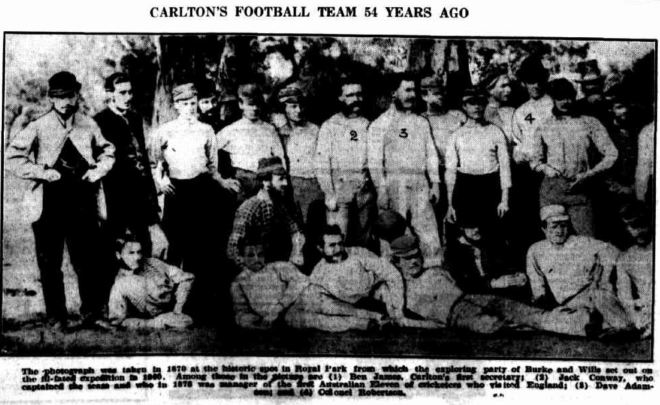
CARLTON’S FOOTBALL TEAM 54 YEARS AGO (1924, September 23). The Herald, p. 1. http://nla.gov.au/nla.news-article243887688
Thomas and his family went back to Melbourne around 1871 and he was soon back playing for the Carlton FC. That year, Carlton played in dark blue uniforms for the first time, having voted to do away with the orange and blue at a meeting on 27 April 1871. On 3 June 1871, Thomas boarded a train for Geelong with the rest of the Carlton team. They were off to a match against the Geelong team captained by Tom Wills. Tom also played in a match between the Bankers and Civil Servants in August 1871.
It appears Tom Gorman’s last game of football with the Carlton Football Club was on 7 October 1871 against Melbourne in the last game of the season for the Challenge Cup. After three hours of play, the Carlton team were the victors and winners of a Challenge Cup for the first time. During his time with the club over six years, Thomas was named for Carlton at least twenty-two times and left his mark on the game -“Who that has seen him play will never forget Tom Gorman, the Carlton heavyweight; there was no slinging with Tom, but a fair shoulder to shoulder and down the opponent came” (6).
A daughter Edith was born in Melbourne in 1872 (7) but soon the family was off to Longwood, south-west of Euroa, and a son Frank was born there in 1874 (8). Thomas was the stationmaster at Longwood and while there, he was called to give evidence in December 1875 at an inquest into a fatal accident on the line near the station. Soon after Tom transferred to Euroa as stationmaster and another two children were born there, Jane in 1876 (9) and Ethel in 1878 (10),
By December 1878, the people of Euroa and the wider district were on edge. The Kelly family from Greta to the north were notorious for their horse-thieving and disorderly behaviour. Their rampaging took a more sinister turn in October 1878, when three policemen were shot dead at Stingy Bark Creek, near Mansfield, while on the hunt for the Kellys. The public was warned the gang would stop at nothing.
It was just before 4 pm on Tuesday 10 December 1878, when a man entered the Euroa National Bank and asked the accountant if he could have a cheque cashed. Before the accountant knew it, a gun muzzle was pressed to his temple. It was Ned Kelly, and he ordered the accountant to “Bail Up”. The gang then gathered up around £2,000 of cash, gold, and silver before taking hostage all those in the bank, removing them to the Faithful Creek station about four miles away along the railway line.
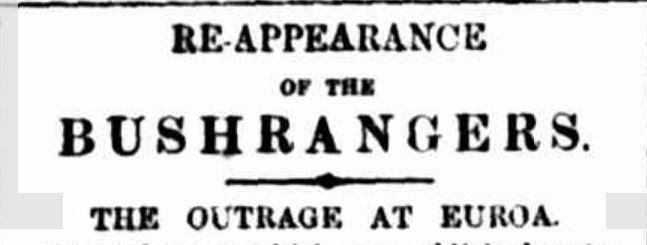
RE-APPEARANCE OF THE BUSHRANGERS. (1878, December 12). The Argus, p. 5. http://nla.gov.au/nla.news-article5924398
It was well planned. The Kellys arrived at Faithful Creek station the day before, taking those there hostage. That evening, a hawker arrived at the station and was taken hostage, and the Kellys fitted themselves out with some new suits for their trip to Euroa. In the morning, Dan Hart was sent ahead to cut the telegraph lines between Faithful Creek and Euroa. With his job done, Dan had a drink at the Euroa pub and waited for the Kellys to reach town.
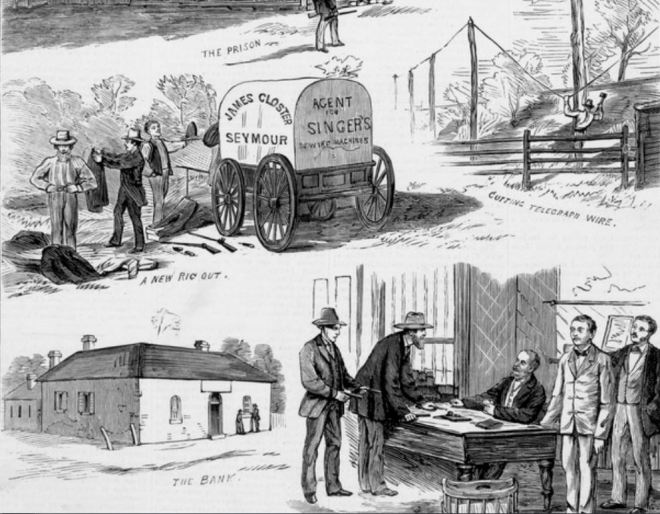
Image courtesy of the State Library of Victoria http://handle.slv.vic.gov.au/10381/244758
The Euroa Railway Station was just across the road from the National Bank, as seen in the view below, looking from the station. The original National Bank is the single-storey building on the right-hand corner. A new bank was built late and is seen on the opposite corner.
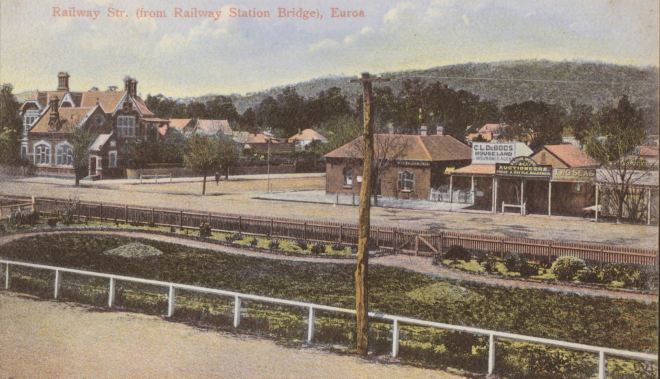
Image courtesy of the State Library of Victoria http://handle.slv.vic.gov.au/10381/295293
It was on that fateful afternoon, Thomas Gorman took the short walk from the station to the bank to cash a cheque. It was only minutes after the Kellys arrived. He knocked on the door but there was no answer and all was quiet inside. He didn’t try the unlocked door but went to the nearby hotel to see if any of the bank staff were in their rooms. With no success, he returned to the bank and knocked again, but when there was no reply he left. What he didn’t know was Dan Hart was guarding the door, ready to shoot anyone who walked through. Good fortune shone upon Thomas that day. If he had turned the handle, at the very least he would have been another hostage, or worse, killed.
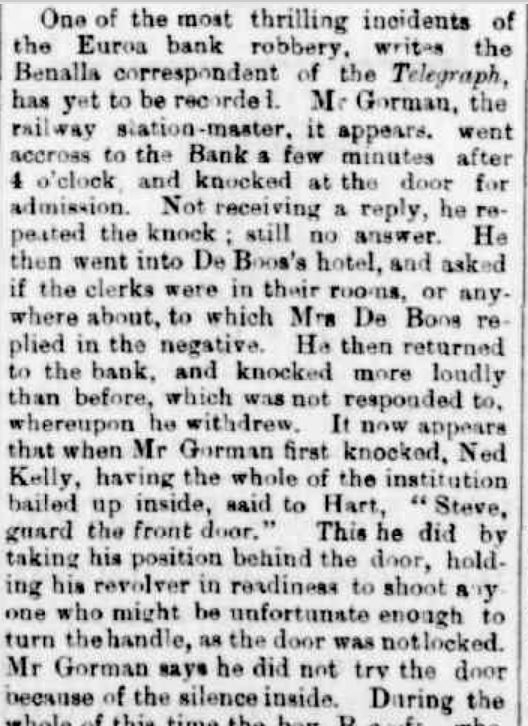
(1878, December 28). The Kyneton Observer, p. 2. http://nla.gov.au/nla.news-article240931231
Earlier in the day, around 2 pm, Thomas had noticed the telegraph was not working and had an inkling it had been cut, but never suspected the Kellys. He had also received word from one of the rail passengers that the line near Faithful Creek station looked like it had blown down. Only an hour before the hold-up, Thomas had organised for the lines to be checked by a passenger on the train to Benalla.
Word of that surveillance didn’t come through until late into the evening but once Thomas had confirmation the lines were down, he set off in the early hours of the morning with other railway staff to repair it but found it too dark to work. They returned at daylight and the line was successfully repaired, but it was a daring operation, considering the location of the Kelly gang was unknown.
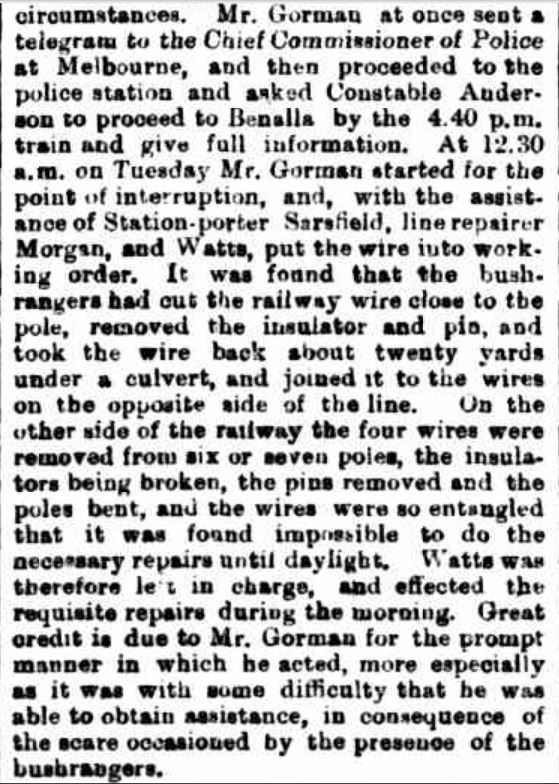
THE KELLY OUTRAGES. (1878, December 13). The Age p. 3.http://nla.gov.au/nla.news-article199352746
In July 1879, it was announced the stationmaster at Hamilton Railway Station had received a promotion and was leaving town. Thomas Gorman was appointed as the new Hamilton stationmaster soon after. The railway at Hamilton had opened only two years prior, and when the Gormans reached the town, a new station was under construction. It was completed by October of that year.
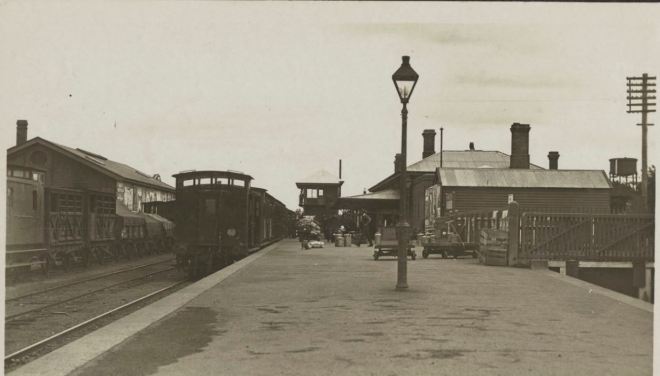
HAMILTON RAILWAY STATION. Image courtesy of the State Library of Victoria http://handle.slv.vic.gov.au/10381/399071
The Kellys were back in the news by August 1879 after a robbery at the Lancefield Bank. That’s when the people of Hamilton learned of their new stationmaster’s encounter with the Kellys. The Spectator on 23 August 1879 included the fact in a report about the latest hold-up. It was a time for visiting experiences, with Thomas travelling to Melbourne to play in a charity match for the Hospital for Sick Children with old players from the Carlton and Melbourne Football clubs on 30 August 1879.
On 6 April 1880, Thomas was elected to the General Committee of the Hamilton Football Club, with George Rippon as the President. George had served as the first president of the Geelong Football Club from 1859 and was among the club’s leading players until 1865. He continued his involvement with the club, including umpiring Challenge Cup matches, until his departure from Geelong for Hamilton in 1876. And while I have found no occasions where Tom and George faced each other on the field, they were sure to have known each other’s football abilities. Also discussed at the meeting was a match challenge by the Carlton Football Club to the Hamilton club.
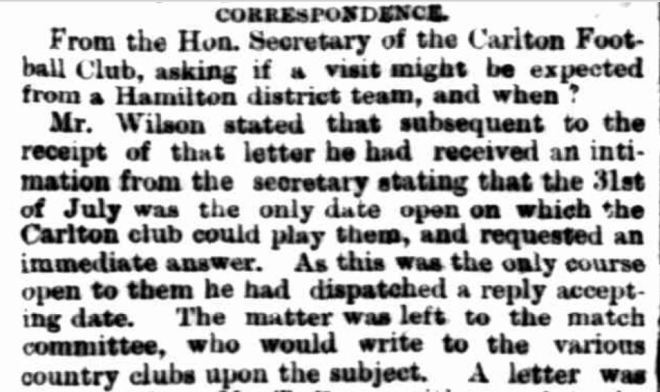
“THE HAMILTON FOOTBALL CLUB.” Hamilton Spectator 6 April 1880: p3. http://nla.gov.au/nla.news-article225488377
The same edition of the Spectator reported Diphtheria, which had been lurking around the district for almost a year, had returned. Four patients were in hospital and another seven were receiving treatment at home. All of those who had contracted the disease had been at the Anglican Church Sunday School picnic at the Nigretta Falls on Easter Monday, 29 March.
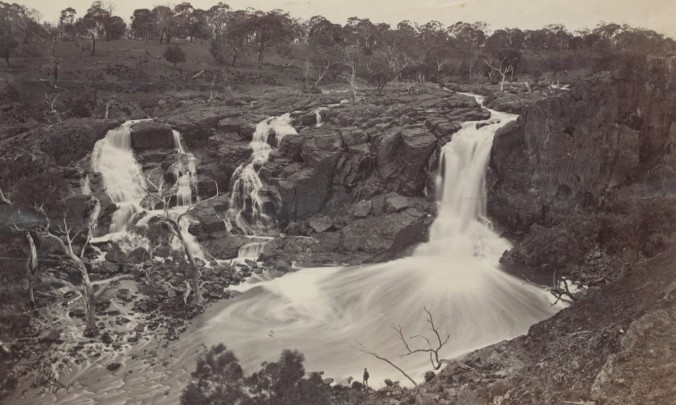
NIGRETTA FALLS, c1878. Photographer: Thomas Washbourne. Image courtesy of the State Library of Victoria http://handle.slv.vic.gov.au/10381/53188
On 9 April, there were two deaths from the disease, Anglican Archdeacon Gustaves Innes and fourteen-year-old Agnes Cresswell.
Within days, diphtheria had reached the Gorman home. Little Ethel, just two years old, fell gravely ill, and soon four-year-old Jane and father Thomas were also showing symptoms. On Tuesday 13 April, the three were taken to the Fever Ward at the Hamilton Hospital, but Ethel died within hours of her arrival and there were grave fears for Jane. The following day, twelve-year-old Thomas Jr was also admitted. By Thursday, Jane Gorman was dead.
At the meeting of the Hamilton Borough Council that week, Mayor William Thomson called for a Royal Commission to investigate how the most recent outbreak occurred since all the children infected to date had been at the picnic at Nigretta Falls and travelled back to Hamilton together. Council voted in favour of such an investigation and also agreed on the construction of a temporary canvas Fever Ward at the hospital to accommodate the growing number of patients. Once the disease was under control, the canvas could be burnt. They also voted to make arrangements for the temporary closure of the Hamilton State School. It was another two weeks before that action was taken.
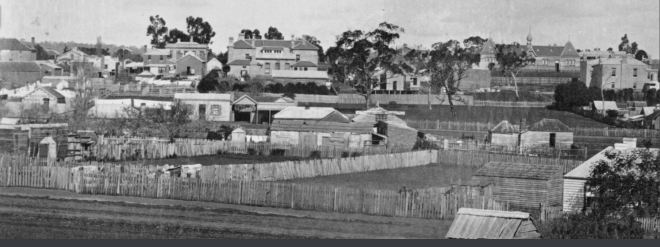
HAMILTON, c1880. Image courtesy of the State Library of South Australia Image no, B 21766/54 collections.slsa.sa.gov.au/resource/B+21766/54
The powers that be in Melbourne did not think a Royal Commission necessary, but members of the Central Board of Health were sent to Hamilton to conduct an inquiry all the same. They heard how through 1879 and until their arrival on 17 April 1880, there had been thirty-two recorded deaths from Diphtheria in Hamilton and surrounding towns. All but two were children.
The inquiry saw much finger-pointing as to who at the picnic could have spread the disease and, with new cases still being reported three weeks after the picnic, how did it continue to spread. The council was accused of allowing waste to build up in street drains. Mr Corbett was made an example of for continuing to deliver goods to the railway station after Diphtheria claimed a son in January and again in the days prior to the inquiry. Even Thomas Gorman, who at the time lay on his sickbed in the Fever Ward was criticised for continuing his stationmaster duties after Edith fell ill.
Meanwhile, Thomas Gorman Jr was in a “low state” and ten-year-old Margaret Gorman was also a patient in the Fever Ward. By Sunday 25 April, Thomas Sr was very ill, but it was reported the following Tuesday he was “much improved” but still listed as critical. Sadly Thomas took another turn for the worse, and he died on Wednesday 28 April. The Spectator delivered the sad news in their next issue. Thomas Gorman the stationmaster and former Carlton Football Club star, was dead. He was thirty-four.
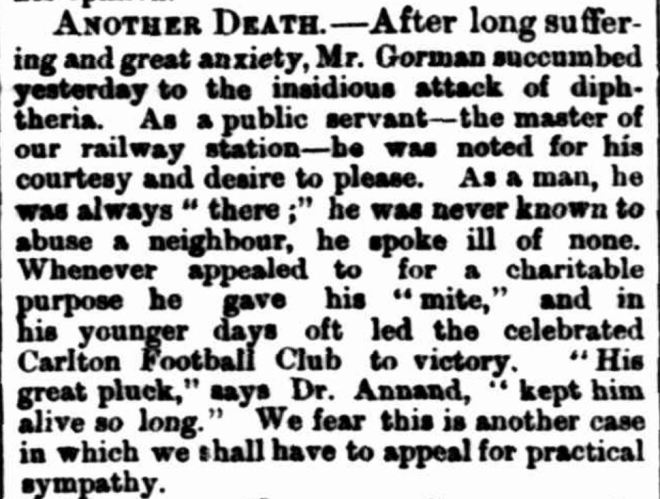
Items of News. (1880, April 29). Hamilton Spectator, p. 2. http://nla.gov.au/nla.news-article225490282
At 5.30 am on Friday 30 April, Thomas Gorman Jr also succumbed to Diphtheria. Just hours later, at 9 am his father was buried in the Church of England section of the Hamilton Cemetery. The Spectator of 1 May noted that despite the early hour, there were many in attendance, including employees from the railway station. They continued,
…no doubt this case is one of the most pitiable that ever occurred in this district…two of his children were struck down by diphtheria. In attending upon them Mr. Gorman caught the disease…every attention was paid to him, but without effect. One by one he saw his children die, and finally, his great courage alone having kept him alive, he followed the two little ones, and another of his children died yesterday.
The Gormans were buried a short distance from others who had died in the weeks before and who had attended the Anglican Sunday School picnic, such as Archdeacon Innes. While the Gormans were Church of England, there is no evidence any of the Gorman children were at the Sunday School picnic, but since all reported cases up to the time of their hospitalisation were said to have been in attendance, it’s highly likely they were.
Some good news came when it was reported Margaret Gorman was discharged from the Fever Ward, but the future looked bleak for her mother Alice. She had lost her husband, her eldest boy, and two baby girls. She had no means of income, no savings, and three children aged ten, eight, and six to support. Local James Tucker started a subscription fund and approached John Gardiner MLC, the captain of the Carlton FC to assist with fundraising.
It was revealed Thomas was approached by an agent weeks before his death offering life insurance, but since funds were tight, he declined. Coincidentally, the Spectator report on that revelation ended with “Such is Life” a phrase which in the years since has been associated with Ned Kelly. Folklore or not, that is said to be his final utterance as he faced the gallows just over five months after Tom’s death.

Items of News. (1880, May 1). Hamilton Spectator p. 2. http://nla.gov.au/nla.news-article225489862
News of Thomas’ passing reached Melbourne with The Australasian of 8 May reporting on the tragic circumstances.
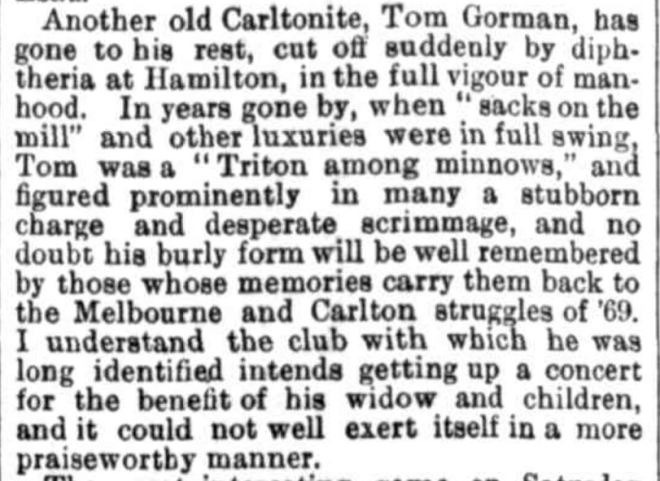
FOOTBALL GOSSIP. (1880, May 8). The Australasian p. 13. http://nla.gov.au/nla.news-article143022196
By the middle of May, Alice and the children had returned to Melbourne taking up residence in Hotham (North Melbourne). Alice enrolled the children at the Errol Street State School but was advised their applications would likely be refused for fear of them spreading diphtheria to the other students.
Meanwhile, plans were well underway for a fundraising concert for the Gorman family. It was planned for the Athenaeum Theatre in Collins Street, Melbourne on 27 May under the patronage of the Victorian Football Association, the Carlton and Melbourne Football Clubs, and the Metropolitan Rifle Corps.
Several singers were booked to entertain the audience, and an address by journalist Edmund Finn arranged.
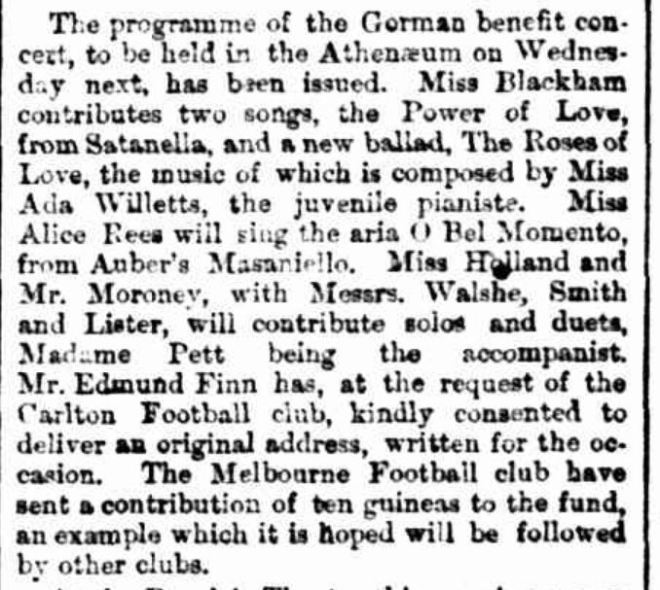
NEWS OF THE DAY. (1880, May 22). The Age, p. 5. http://nla.gov.au/nla.news-article202140330
The concert was well attended with £25 raised for the family. An extract of Edmund Finn’s tribute delivered on the night is below. You can read it in full on the link – The Late Mr Thomas Gorman by Edmund Finn
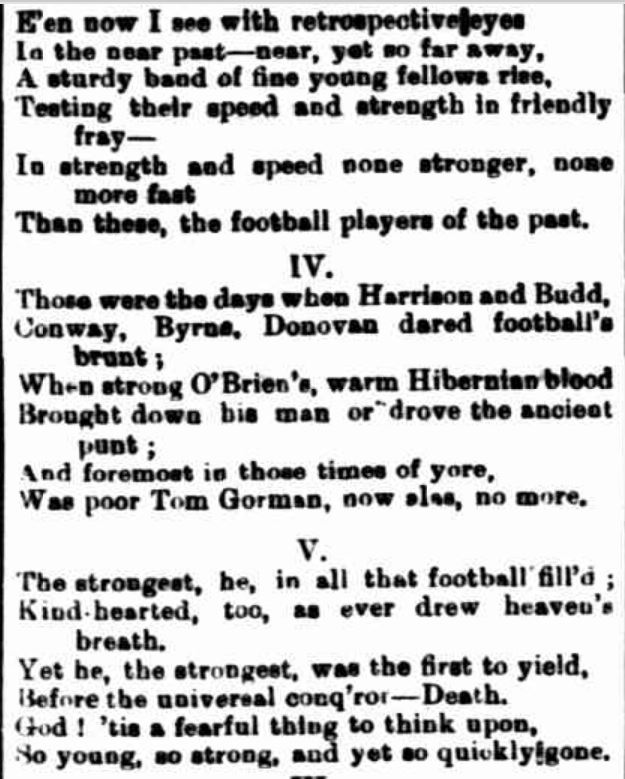
THE LATE MR. THOMAS GORMAN. (1880, July 3). Hamilton Spectator p. 1 (SUPPLEMENT TO THE HAMILTON SPECTATOR). http://nla.gov.au/nla.news-article225485876
Meanwhile, at Hamilton on 29 May, a cheque for £100 was made out to Alice Gorman. By August, just over £193 was raised for the family. By then Alice was ill with heart palpitations and money already raised was dwindling because of doctors’ fees.
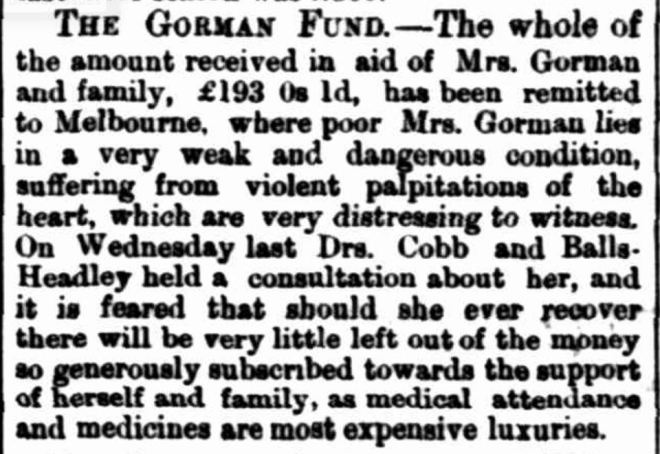
Items of News. (1880, August 17). Hamilton Spectator, p. 2. http://nla.gov.au/nla.news-article225488082
Alice recovered and by the end of the year was appointed to take over the station and post office at Joyce’s Creek between Maryborough and Castlemaine.
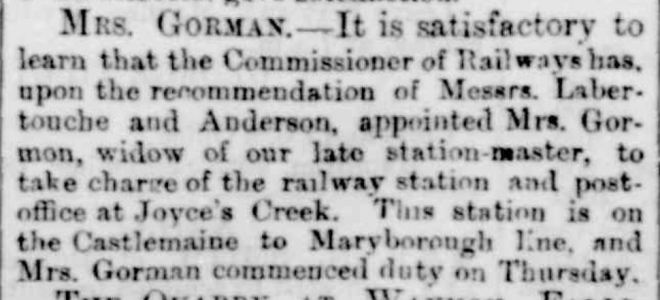
[?] of News. (1880, December 11). Hamilton Spectator p. 2. http://nla.gov.au/nla.news-article225485819
And so continued the Gorman family connection with Victorian Railways. Alice was later stationmistress at Northcote Station (later known as Merri Station) with daughter Margaret as her assistant (11). Alice died in Clifton Hill in 1938, aged ninety-two (12)
By 1909, Margaret was thirty-nine and the caretaker of Croxton Station near Thornbury. She then moved on to Glen Iris Station. While there, Margaret had an experience similar to her father’s at Euroa when the ticket box was held up one evening. It was reported a gun was pointed at her during the robbery in April 1924, but that was later retracted. Margaret was left shaken by the incident.
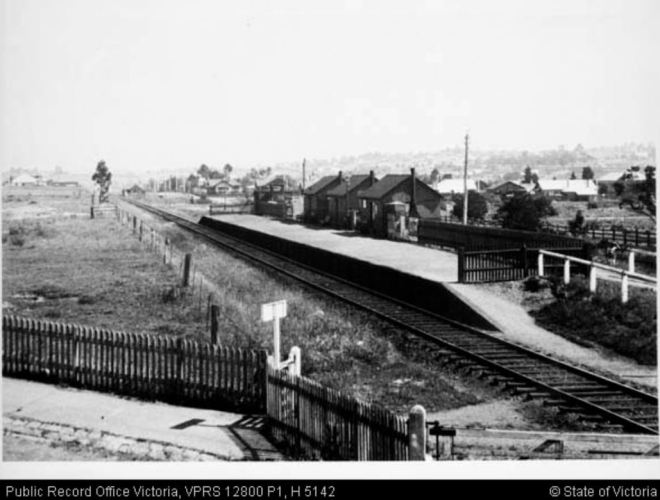
GLEN IRIS STATION c1920. Image courtesy of the Public Record Office of Victoria wiki.prov.vic.gov.au/index.php/VPRS_12800_P1_H_5142
Margaret next worked as an inspector with Victorian Railways (13) until her retirement. She never married and died at St Kilda in 1957 at the age of eighty-six. (14)
Frank Gorman also worked with Victorian Railways but moved to New Zealand and worked on the railways there. He was in that country when WW1 broke and he enlisted and served with the New Zealand Army. On his return to New Zealand, he resumed his work on the railways but died on 18 March 1925. He was working as a guard at Kapuni on the North Island when the train on which he was travelling, hit a cow. Frank died as a result.
The youngest of the surviving Gorman children, Edith, married watchmaker Samuel Haymes in 1897 (15). She lived most of her married life in North Melbourne. Edith died at Sans Souci, New South Wales on 12 December 1951.
No doubt Alice, Margaret, Frank, and Edith thought often of those they left behind in Hamilton in April 1880. In football circles for years to come when old-timers remembered back to the players in the early days of the Carlton Football Club, the name of Tom Gorman and that of his brother William were among those raised.
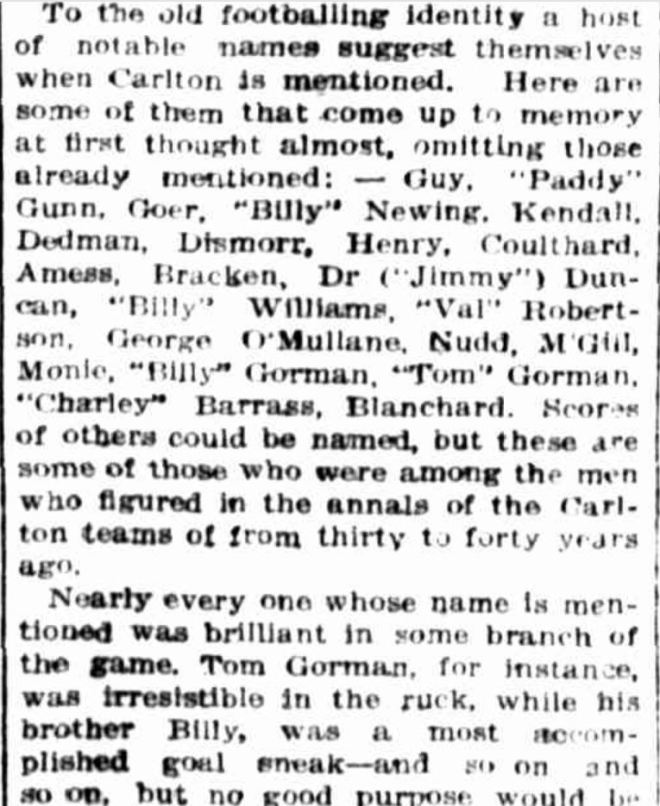
OLD CARLTON. (1909, July 19). The Herald, p. 4. http://nla.gov.au/nla.news-article242063149
Today, Tom’s platform at Hamilton has long been quiet.
At Tom’s final resting place with his children Thomas Jr., Jane, and Ethel, the headstone donated by his friends, lies broken. Almost 140 years on, there is no one left to visit and the grave wouldn’t warrant a second glance from passers-by. Little do they know the significance of those who lay below. Not just the connection to Australia’s homegrown sport and two great clubs of the game but also their part in one of the darkest periods of Hamilton’s history. That alone should never be forgotten.
GAMES RECORD OF THOMAS GORMAN
The following games were taken from team lists found in newspapers at Trove.
CARLTON
| DATE | OPPONENT | GORMAN | ||
| 27 May 1865 | Melbourne Grammar School | Gorman | ||
| 10 June 1865 | Warehouseman | Gorman | ||
| 15 July 1865 | Williamstown | Thomas & William | ||
| 22 July 1865 | Warehouseman | Thomas & William | ||
| 5 August 1865 | Royal Park | Thomas & William | ||
| 26 August 1865 | Warehouseman | Thomas & William | ||
| 5 May 1866 | Intraclub | Thomas & William | ||
| 9 June 1866 | South Yarra | Thomas & William | ||
| 16 June 1866 | Emerald Hill | Thomas & William | ||
| 30 June 1866 | Melbourne | Thomas & William | ||
| 21 July 1866 | Melbourne | Thomas & William | ||
| 4 August 1866 | South Yarra | Thomas & William | ||
| 18 August 1866 | Melbourne | Thomas & William | ||
| 1 September 1866 | South Yarra | Thomas & William | ||
| 22 June 1867 | Melbourne | Thomas & William | ||
| 6 July 1867 | South Melbourne | Thomas & William | ||
| 24 August 1867 | Melbourne | Gorman | ||
| 27 May 1871 | Geelong | Thomas | ||
| 10 June 1871 | Melbourne | Thomas | ||
| 24 June 1871 | Collingwood | Thomas | ||
| 15 July 1871 | Melbourne | Thomas | ||
| 22 July 1871 | Albert Park | Thomas & William | ||
| 5 August 1871 | Melbourne | Thomas* | ||
| 19 August 1871 | South Yarra | Thomas | ||
| 2 September 1871 | Melbourne | Gorman | ||
| 7 October 1871 | Melbourne | Thomas |
*William emergency
MELBOURNE
| DATE | OPPONENT | GORMAN | ||
| 16 September 1865 | South Yarra | Gorman | ||
| 16 June 1866 | Civil Servants | William (Melbourne) Tom (Civil Servants)* | ||
| 23 June 1866 | The Banks | Thomas and William** | ||
| 7 July 1866 | The World | Thomas and William | ||
| 14 July 1866 | South Yarra | Thomas and William | ||
| 11 August 1866 | South Yarra | Thomas and William | ||
| 25 August 1866 | South Yarra | Thomas and William | ||
| 15 September 1866 | South Yarra | Thomas and William |
*Thomas and William were down to play two games on 16 June 1866. Both were selected to play for Carlton against Emerald Hill in a Challenge Cup match. Also, William was selected for Melbourne to play in a match against the Civil Service, a team on which Thomas was selected. Results found for the Melbourne vs Civil Service show the Gormans did play in that match. Results for the Carlton vs Emerald Hill were not found in the newspapers available.
**Intraclub match for Melbourne – Australians v The World
SOURCES
1. NSW Birth Index, Thomas GORMAN, Reg. No. 312/1845 V1845312 62
2. NSW Birth Index, William GORMAN, Reg. No. 349/1848 V1848349 65
3. Victorian Marriage Certificate, Alice Ann TRAVIS, Reg. No. 3024 / 1867
4. Victorian Birth Index, Thomas GORMAN, Reg. No. 17999 / 1868
5. Victorian Birth Index, Margaret GORMAN, Reg. No. 13969 / 1870
6. Centenary Souvenir of the Carlton Football Club: from 1864-1933 by Colin Martyn 1934
7. Victorian Birth Index, Edith Agnes GORMAN, Reg. No. 25040 / 1872
8. Victorian Birth Index, Frank GORMAN, Reg. No. 23736 / 1874
9. Victorian Birth Index, Jane GORMAN, Reg. No. 16122 / 1876
10. Victorian Birth Index, Ethel May GORMAN, Reg. No. 15844 / 1878
11. Electoral Rolls, Victoria, Bourke, Subdistrict of Northcote, Alice Ann GORMAN, 1906
12 Victorian Death Index, Alice Ann GORMAN, Reg. No. 8175 / 1938
13. Electoral Rolls, Victoria, Victoria, Batman, Subdistrict of Northcote, Margaret Alice GORMAN, 1934
14. Victorian Death Index, Margaret GORMAN, Reg. No. 242 / 1957
15. Victorian Marriage Index, Edith GORMAN, Reg No. 6942 / 1897
©2020 Merron Riddiford
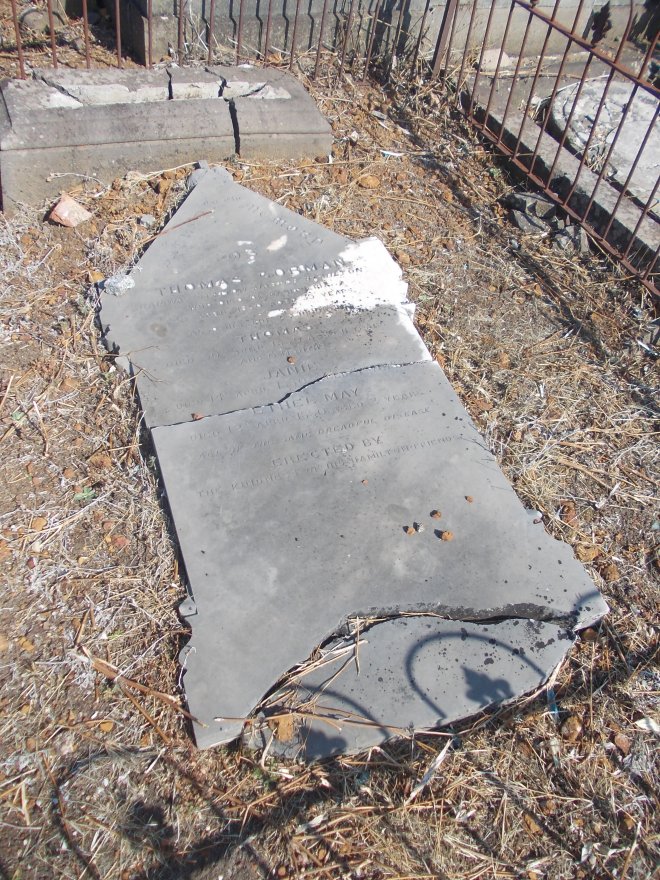

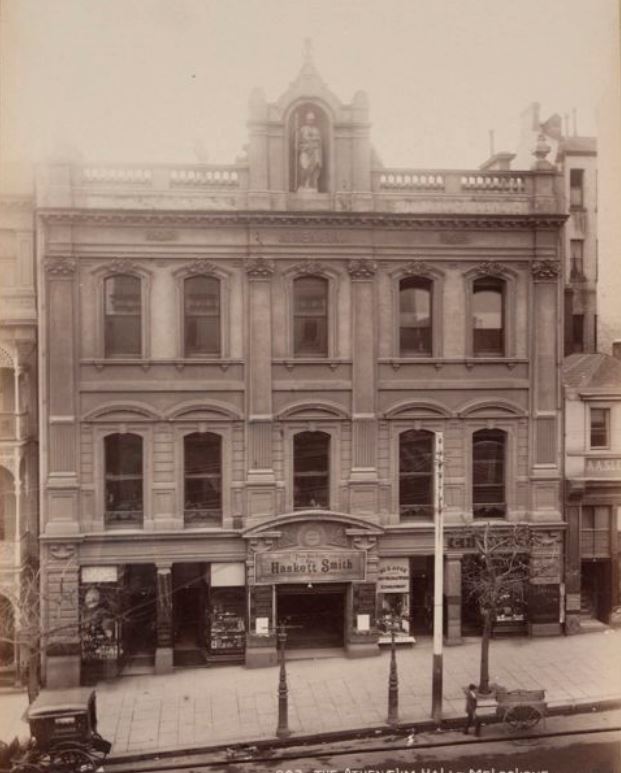
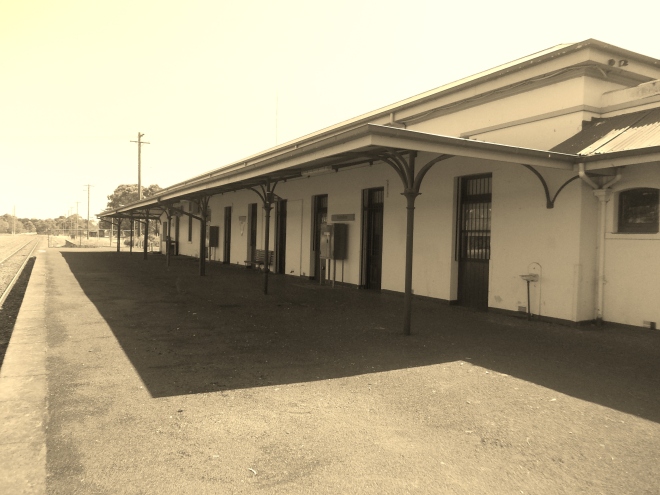
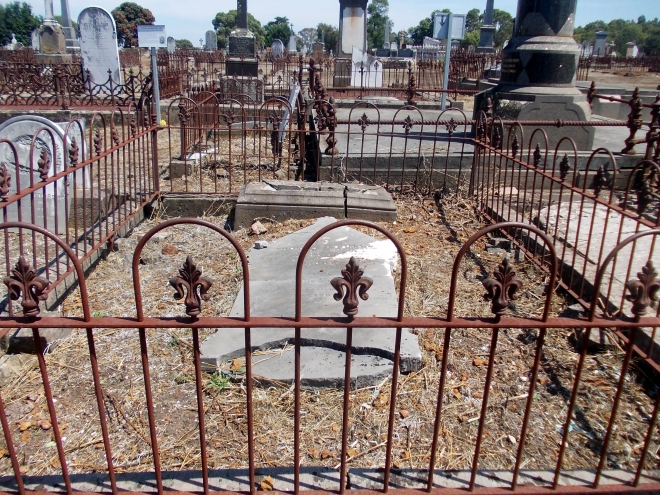

What an amazing story and great research
LikeLiked by 2 people
Thank you, Jane. It certainly is quite a story.
LikeLiked by 1 person
Merron, well put together.
The Carlton Football Club history site called Blueseum (www.blueseum.org) has a lot of this information and images of Tom.
For a direct link to Tom Gorman’s bio page – https://www.blueseum.org/Tom+Gorman
LikeLiked by 1 person
Thanks Thea, I know the Blueseum site well.
LikeLiked by 1 person